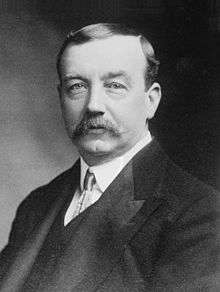United Kingdom general election, January 1910
| |||||||||||||||||||||||||||||||||||||||||||||||||||||||||||||||||||||||||||||
All 670 seats in the House of Commons 336 seats needed for a majority | |||||||||||||||||||||||||||||||||||||||||||||||||||||||||||||||||||||||||||||
| |||||||||||||||||||||||||||||||||||||||||||||||||||||||||||||||||||||||||||||
|
Colours denote the winning party. | |||||||||||||||||||||||||||||||||||||||||||||||||||||||||||||||||||||||||||||
| |||||||||||||||||||||||||||||||||||||||||||||||||||||||||||||||||||||||||||||
The United Kingdom general election of January 1910 was held from 15 January to 10 February 1910. The government called the election in the midst of a constitutional crisis caused by the rejection of the People's Budget by the House of Lords, in order to get a mandate to pass the budget.
The election produced a hung parliament, with the Conservative Party led by Arthur Balfour and their Liberal Unionist allies receiving the largest number of votes, but the Liberals led by H. H. Asquith winning the largest number of seats, returning two more MPs than the Conservatives. Asquith formed a government with the support of the Irish Parliamentary Party, led by John Redmond. A second election was soon held in December.
The Labour Party, led by Arthur Henderson, continued to gain strength, going from 29 seats to 40.
Results
| 274 | 272 | 71 | 40 | 13 |
| Liberal | Conservative | IP | Lab | O |
| Candidates | Votes | ||||||||||
|---|---|---|---|---|---|---|---|---|---|---|---|
| Party | Leader | Standing | Elected | Gained | Unseated | Net | % of total | % | No. | Net % | |
| Conservative and Liberal Unionist | Arthur Balfour | 594 | 272 (240+32) | 130 | 14 | +116 | 40.6 | 46.8 | 2,919,236 | +3.4 | |
| Liberal | H. H. Asquith | 511 | 274 | 12 | 135 | −123 | 40.9 | 43.5 | 2,712,511 | −5.4 | |
| Labour | Arthur Henderson | 78 | 40 | 17 | 6 | +11 | 6.0 | 7.0 | 435,770 | ||
| Irish Parliamentary | John Redmond | 85 | 71 | 0 | 11 | −11 | 10.6 | 1.2 | 74,047 | +0.6 | |
| All-for-Ireland | William O'Brien | 10 | 8 | 8 | 0 | +8 | 1.2 | 0.4 | 23,605 | ||
| Independent Nationalist | N/A | 10 | 3 | 3 | 2 | +2 | 0.5 | 0.3 | 16,533 | ||
| Social Democratic Federation | H. M. Hyndman | 9 | 0 | 0 | 0 | 0 | 0.2 | 13,479 | -0.1 | ||
| Independent Conservative | N/A | 4 | 1 | 1 | 1 | 0 | 0.1 | 0.2 | 11,772 | ||
| Free Trader | John Eldon Gorst | 4 | 0 | 0 | 0 | 0 | 0.2 | 11,553 | |||
| Independent Labour | N/A | 6 | 0 | 0 | 1 | −1 | 0.2 | 9,936 | |||
| Independent Liberal | N/A | 3 | 1 | 1 | 0 | +1 | 0.1 | 0.1 | 5,237 | ||
| Scottish Prohibition | Edwin Scrymgeour | 1 | 0 | 0 | 0 | 0 | 0.0 | 756 | |||
All parties shown.

Voting summary
Seats summary
See also
- MPs elected in the United Kingdom general election, January 1910
- The Parliamentary Franchise in the United Kingdom 1885-1918
References
External links
Further reading
- Blewett, Neal. The Peers, the Parties and the People: The General Elections of 1910 (1972)
- Clarke, P. F. "The electoral position of the Liberal and Labour parties, 1910-1914." English Historical Review 90.357 (1975): 828-836.
- F. W. S. Craig, British Electoral Facts: 1832-1987
- O’Brien, Phillips Payson. "The 1910 Elections and the Primacy of Foreign Policy." in William Mulligan and Brendan Simms, eds., The Primacy of Foreign Policy in British History, 1660–2000 (Palgrave Macmillan UK, 2010) pp. 249–259.
- Pelling, Henry. Social Geography of British Elections 1885–1910 (1967)
- Sykes, Alan. Tariff Reform in British Politics: 1903-1913 (Oxford University Press, 1979)
- Sykes, Alan. "The Confederacy and the purge of the Unionist free traders, 1906–1910." Historical Journal 18#2 (1975): 349-366.
- Wald, Kenneth D. "Class and the vote before the first world war." British Journal of Political Science 8#4 (1978): 441-457. online
External links
- Spartacus: Political Parties and Election Results
- United Kingdom election results - summary results 1885-1979



